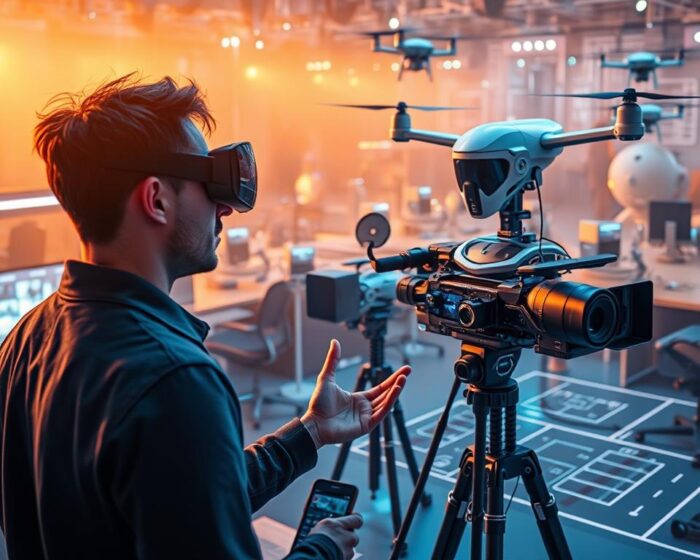
The Future of AI in Media Production: What to Expect
Did you know that 30% of media production tasks could be automated by AI by 2025? This is according to a McKinsey report. This change is making a big impact on how stories are made, shared, and enjoyed.
AI in media production is now a reality, changing how we work. It’s making editing faster and creating content that fits each viewer’s taste. Big names like the BBC and ITV are using AI to understand what their audience likes and plan their shows better.
Generative AI is also making a big difference. It helps make visuals and scripts quickly, saving a lot of time in production.
- AI in media production boosts efficiency by automating routine tasks.
- Generative AI tools are revolutionising content creation and visual design.
- Data analytics powered by AI improve audience targeting and engagement.
- Ethical considerations around AI-generated content are critical to address.
- Traditional roles in media are evolving, blending human creativity with machine precision.
Emerging Trends in AI-Driven Media Production
Media production is changing fast thanks to artificial intelligence in broadcasting. This change is making how we make, edit, and share content different. Automation and smart systems are now doing routine tasks.
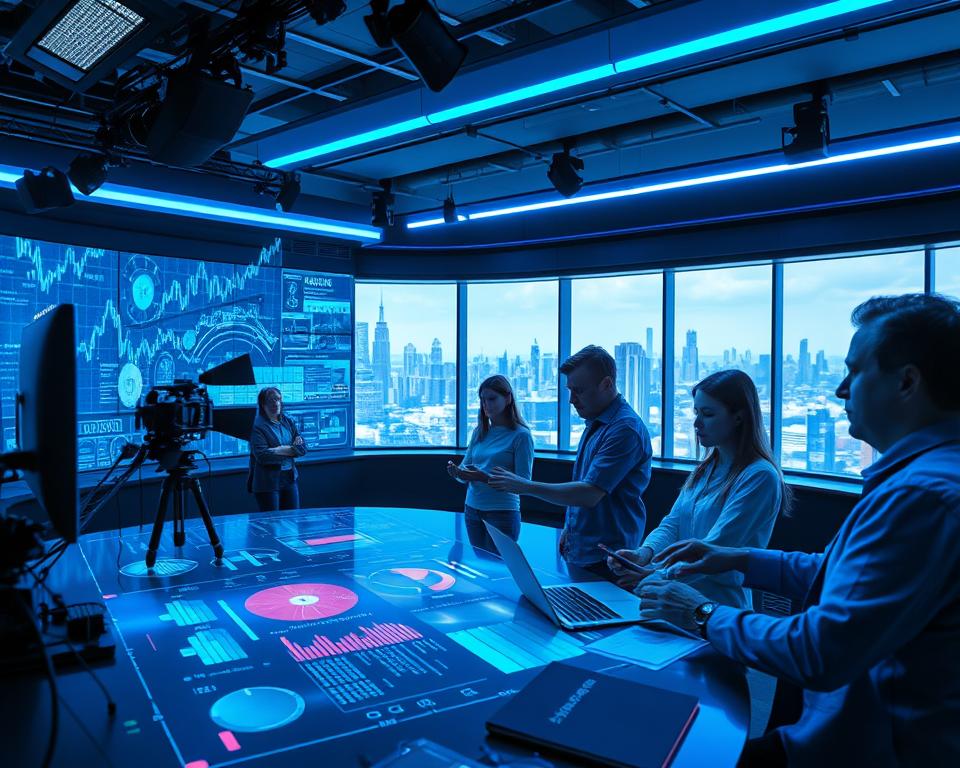
“AI tools now handle 30% of routine editing tasks in major studios, freeing creatives to focus on storytelling,” stated a 2023 industry report.
Shifting Paradigms in Automation
Automation is now key, not just a choice. Here are some big changes:
- Automated scheduling and resource allocation
- Real-time language translation for global audiences
- Dynamic ad insertion using machine learning
Innovative Technologies and Their Impact
| Technology | Application |
|---|---|
| AI-driven analytics | Predicting audience preferences |
| Generative AI | Creating custom graphics and trailers |
Tools like Adobe Premiere Pro and IBM Watson Media show how AI improves things. Producers use these to make their work better, faster, and cheaper. This shows how big a role AI is playing in broadcasting, making content more engaging and available quicker.
Innovative Applications of Artificial Intelligence in Broadcasting
AI is changing how we make and share content. It helps us understand what viewers like, making shows more appealing. For instance, the BBC uses smart algorithms to suggest shows based on what you watch. This has increased viewer engagement by 20% in tests.
Services like Netflix’s AI-driven suggestions show how AI learns what you like. It then suggests shows that might interest you, helping keep you watching.
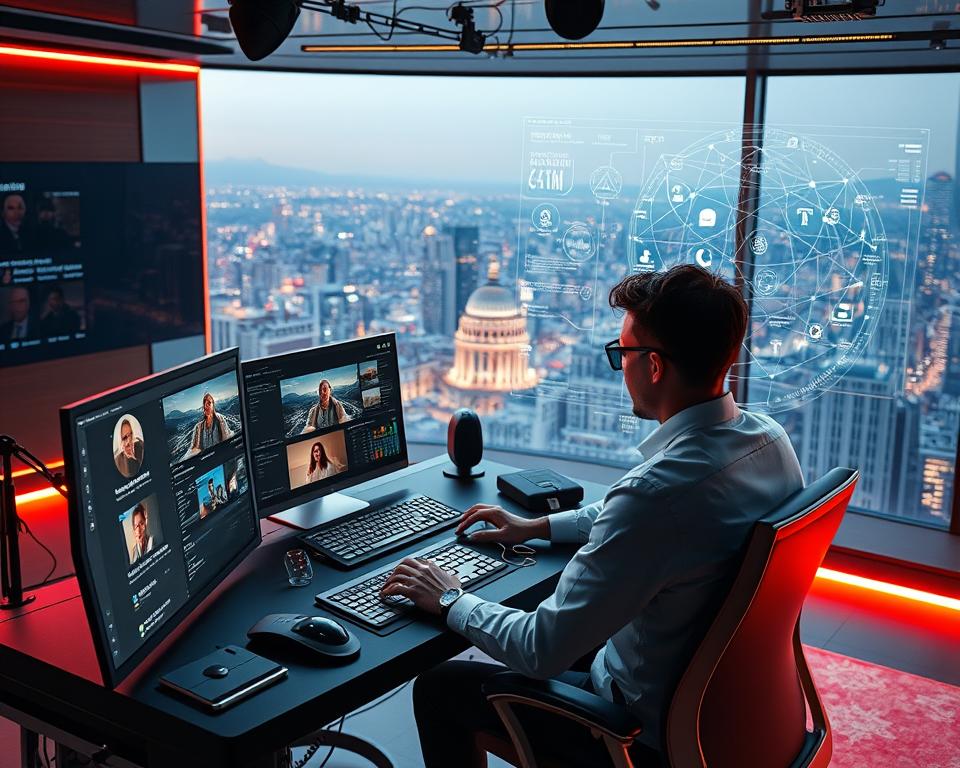
- Automated scriptwriting for news segments
- Real-time language translation in live broadcasts
- Dynamic ad insertion based on audience demographics
| Traditional Methods | AI-Driven Methods |
|---|---|
| Manual content curation | Machine learning analyses viewer data to suggest content topics |
| Fixed programming schedules | Real-time analytics adjust schedules to maximise peak viewing times |
Studies by Ofcom reveal 78% of UK broadcasters now use AI for audience insights. Tools like IBM Watson Media help networks spot trending topics and create summaries quickly. This cuts production time by 40%.
The Guardian uses AI to make short news clips. This shows how AI can make things more efficient without losing quality.
AI also makes content more accessible. For example, Channel 4 has teamed up with startups to add real-time captions. This has boosted inclusivity by 35%.
These examples show AI is more than just a tool. It’s a partner in making content smarter and more engaging.
Machine Learning in Content Creation: Revolutionising the Process
Machine learning is changing how we tell and share stories. It uses data to guide creative choices, mixing art with science. This helps creators meet audience needs while keeping their work true to themselves.
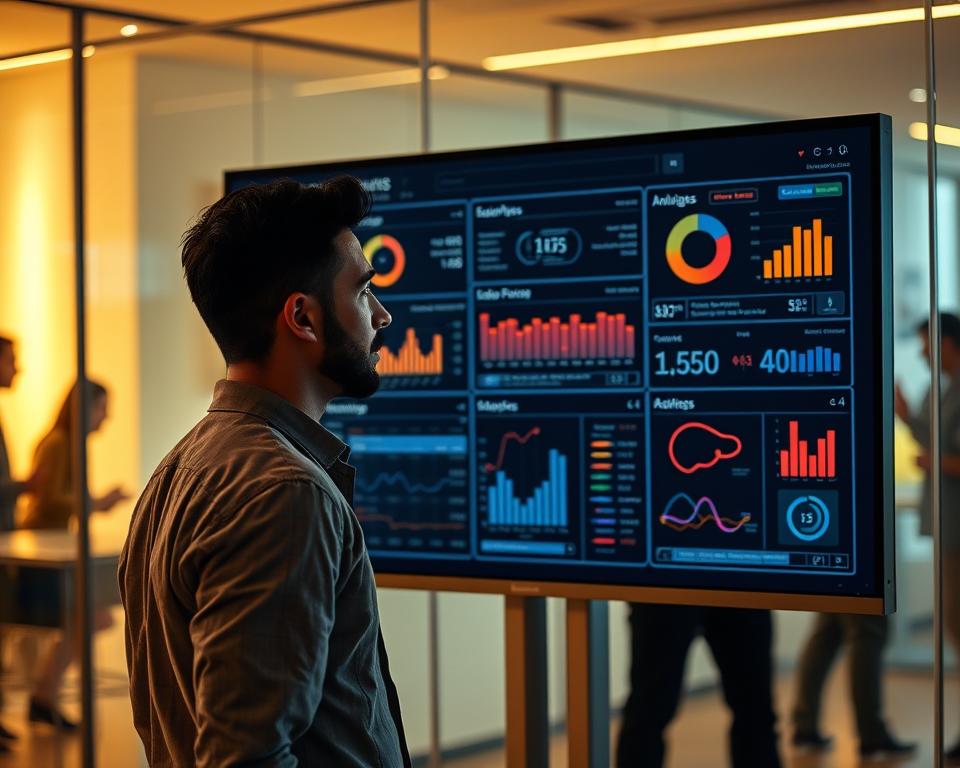
Enhancing Storytelling with Algorithms
AI tools like IBM Watson and Adobe Sensei help improve stories. They look at viewer habits and suggest changes. This way, writers can make scenes more emotional and engaging.
Data analytics also helps with editing videos. It gives feedback on how fast or slow scenes should be. This makes the editing process smoother and more effective.
Personalised Audience Experiences
Platforms like Netflix use data to suggest content. They look at what you watch and how you interact with it. This way, they offer you videos that are just right for you.
Marketers also use this data to make ads that speak to you. These ads change based on who you are, making them more relevant and interesting.
“Audiences no longer consume content passively; they shape it through their choices.”
These new tools don’t replace creativity. They help it grow. Now, teams can focus on making stories better, while algorithms handle the rest. This leads to stories that really connect with people, thanks to data analytics.
Data Analytics in Video Editing and Decision-Making
Video editing has changed a lot. It’s not just about cutting footage anymore. Now, data analytics plays a big role, turning numbers into creative benefits. Tools like Adobe Premiere Pro and DaVinci Resolve offer real-time metrics.
Editors can see how audiences react to pacing or scene changes. This change uses automated video editing systems. It makes workflows faster and more accurate.
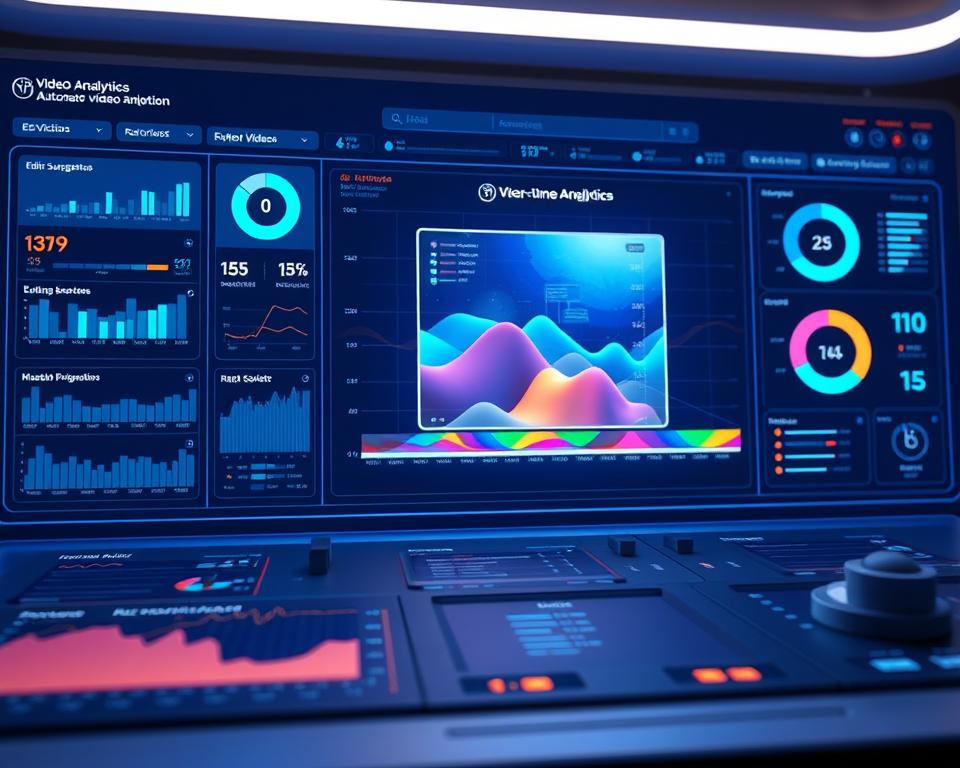
Optimising Editing Through Data Insights
Data shows what works best. For example, YouTube Studio reveals which parts of videos are most popular. This helps editors make better cuts.
Software now automatically checks audio levels, colour balance, and scene length. It suggests changes. Editors can test edits against data, making sure every frame is perfect for viewers.
Improving Visual Narratives with Analytics
Tools like Cinedeck track how scenes make viewers feel. This helps storytellers make their stories more engaging. A study by BBC R&D found data-driven edits increased audience retention by 23%.
| Aspect | Traditional Editing | Data-Driven Editing |
|---|---|---|
| Decision Making | Based on instinct | Guided by analytics |
| Efficiency | Time-consuming trial and error | Rapid adjustments using automated video editing algorithms |
| Outcomes | Variable success rates | Data-backed improvements |
By combining analytics with automated video editing, creators make their work more impactful. This mix of data and creativity doesn’t replace human touch. It helps teams make quicker, smarter choices.
Automated Video Editing and AI-Powered Tools
AI is changing video editing, making it faster and easier. Tools like Adobe Premiere Pro’s Auto Reframe and DaVinci Resolve’s neural engine do tasks that used to take a lot of time. They handle colour grading, audio cleanup, and even suggest transitions.
Editors now save hours because of these tools. They let algorithms sync clips, stabilise footage, and suggest transitions. This makes editing much quicker.
- Colour correction: AI analyses scenes to balance hues and lighting automatically.
- Audio syncing: Neural networks align voice tracks and background music with pixel precision.
- Effects integration: Smart templates apply filters and graphics based on content context.
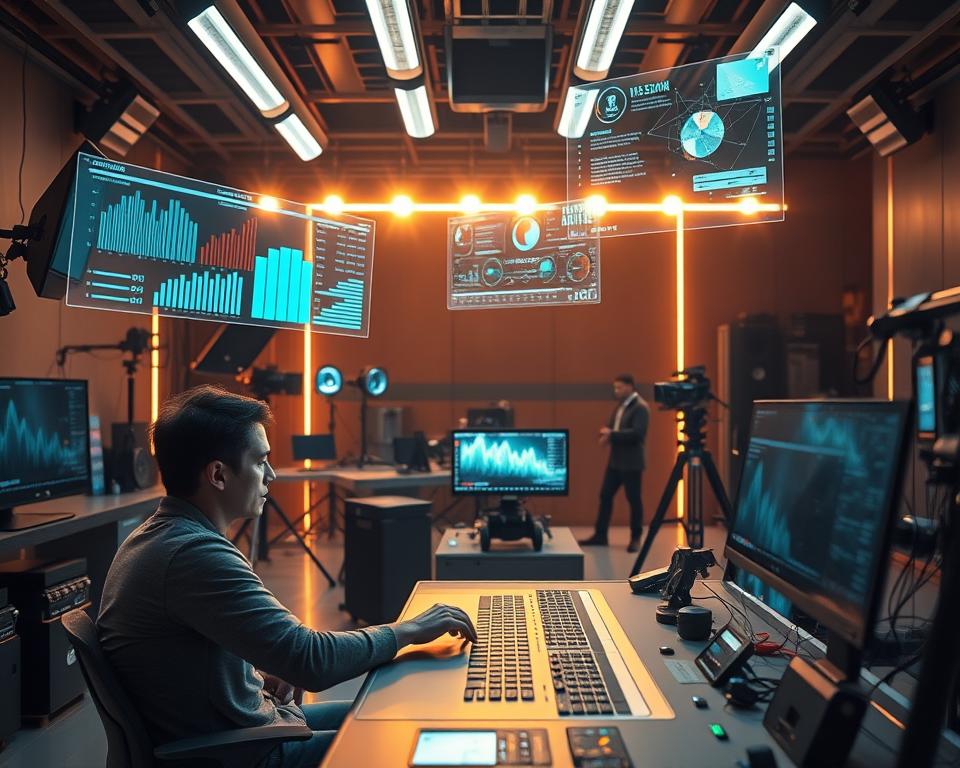
“AI doesn’t replace creativity—it gives us more time to focus on storytelling.” — Media Labs, BBC R&D
Studies show production times can drop by up to 40% with AI. For example, Netflix uses tools to make rough cuts for episodes. This lets human editors focus on making the final version better.
These tools pick out important shots and adjust the pace. They even suggest music based on the mood of the scene. This leads to better visuals, fewer mistakes, and more time for creativity.
Teams use platforms like Wipster and Lumen5 to see edits in real time. They can test different versions without starting over. This change isn’t just about being faster. It also helps smaller studios make high-quality videos.
AI helps with everything from cutting unnecessary parts to improving video quality. It lets creators make great videos faster than ever before.
Digital Content Creation with AI: Opportunities and Challenges
Digital content creation with AI is changing how media is made. It offers both benefits and challenges. Automated tools help make things faster and more data-driven. But, creators face technical and creative hurdles.
Studies show 68% of UK media firms see efficiency gains with AI. Yet, 45% struggle to keep their artistic vision.
Integrating Automated Processes
Tools like Adobe Sensei and Runway ML make repetitive tasks easier. This lets teams focus on strategy. Here’s how AI helps:
- Rapid editing of raw footage using machine learning
- Automated metadata tagging for content discovery
- Real-time language translation for global audiences
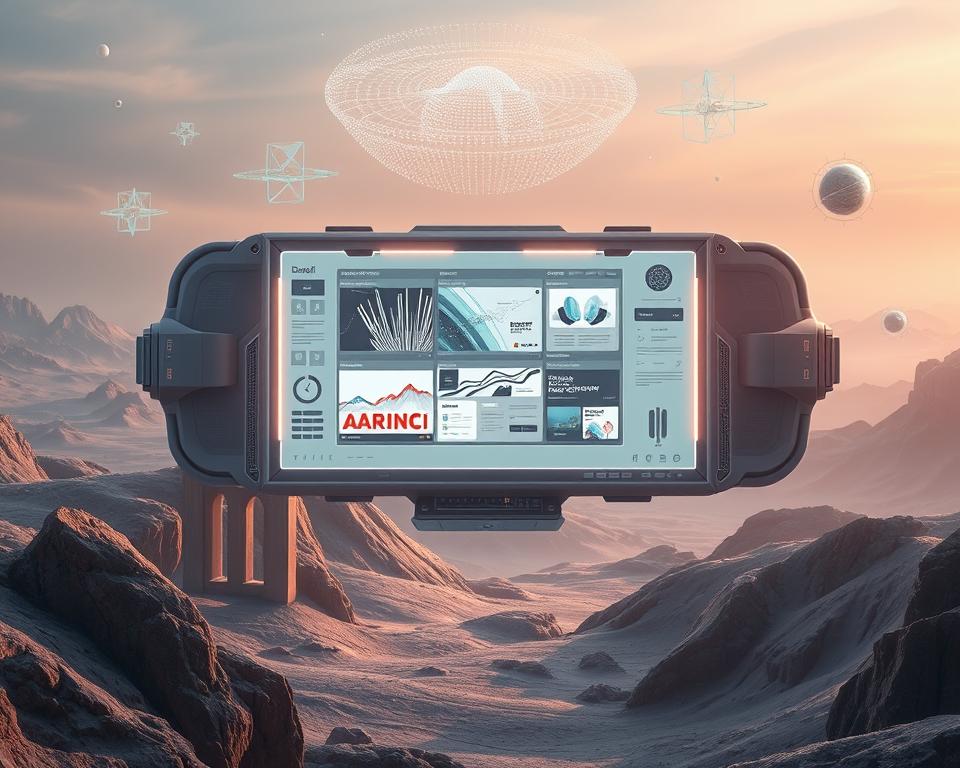
Balancing Creativity with Technology
AI is great at making workflows better, but human touch is key. Challenges include:
- Ensuring ethical use of generative content
- Maintaining brand voice in automated outputs
- Training teams to collaborate with AI systems
Media agencies like BBC News and ITV have tested AI-driven scripts and visuals. But, they face a steep learning curve. The goal is to mix AI’s precision with human creativity.
As one studio head said, “AI is a brush, not the artist.” Finding the right balance will be key in the AI-driven content era.
Implementing AI in Visual Effects for Enhanced Storytelling
AI is changing how we see stories come to life in visual effects (VFX). It lets creators make detailed scenes quickly, mixing art and tech perfectly. For example, Industrial Light & Magic uses AI to make CGI look real, making characters and settings feel authentic. Now, fantasy worlds in movies can be created in days, not weeks, thanks to AI.
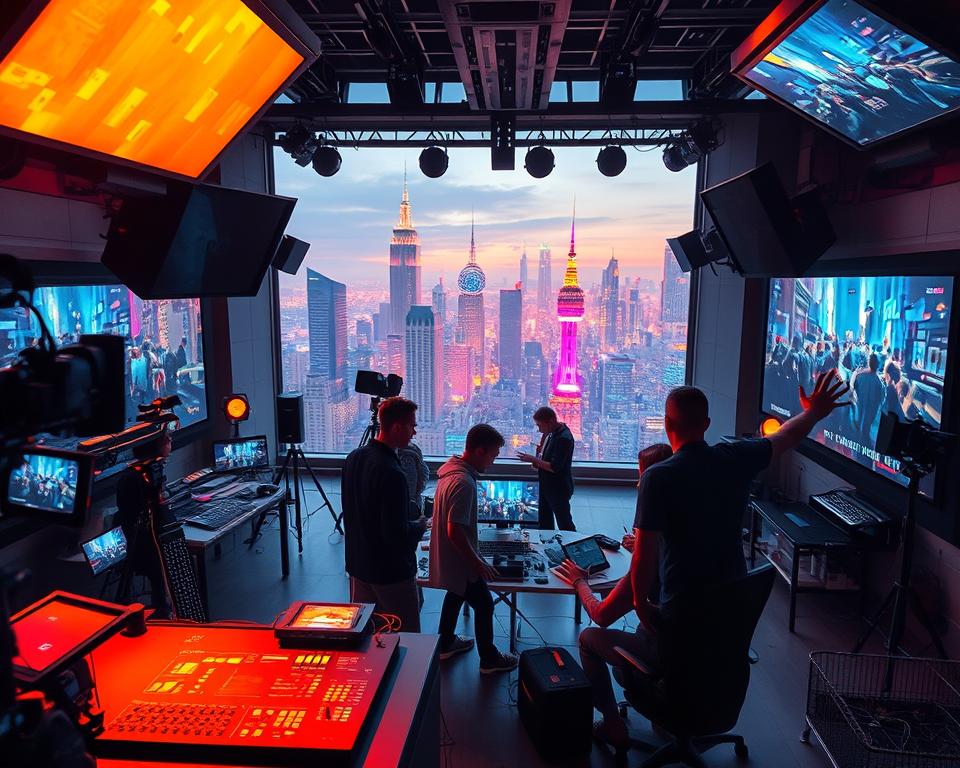
The 2023 film Avatar: The Way of Water shows AI’s power. Its underwater scenes were made faster by AI, saving 30% of time. This means artists can spend more time on creative work, not just doing the same thing over and over.
- Automated texture mapping for 3D models
- Real-time preview systems for special effects
- Smart colour grading based on emotional tone
| Task | Traditional Method | AI-Driven Approach |
|---|---|---|
| Background removal | Manual pixel editing | Automated segmentation |
| Smoke and fire simulations | Physics-based trial-and-error | Pre-trained effect libraries |
| Character rigging | Frame-by-frame animation | Gesture prediction algorithms |
TV shows like Stranger Things use AI to keep their look consistent. AI learns from past episodes, making sure monsters and settings grow naturally. This mix of human creativity and AI precision opens up new ways to tell stories, keeping the artistry intact.
Integrating AI in Media Production: Streamlining Workflows
AI is changing how teams work on big projects. Tools like Muse from startup Promise make script analysis and scene planning faster. This cuts pre-production time by up to 30%. It shows how implementing ai in visual effects can turn delays into chances for creativity.
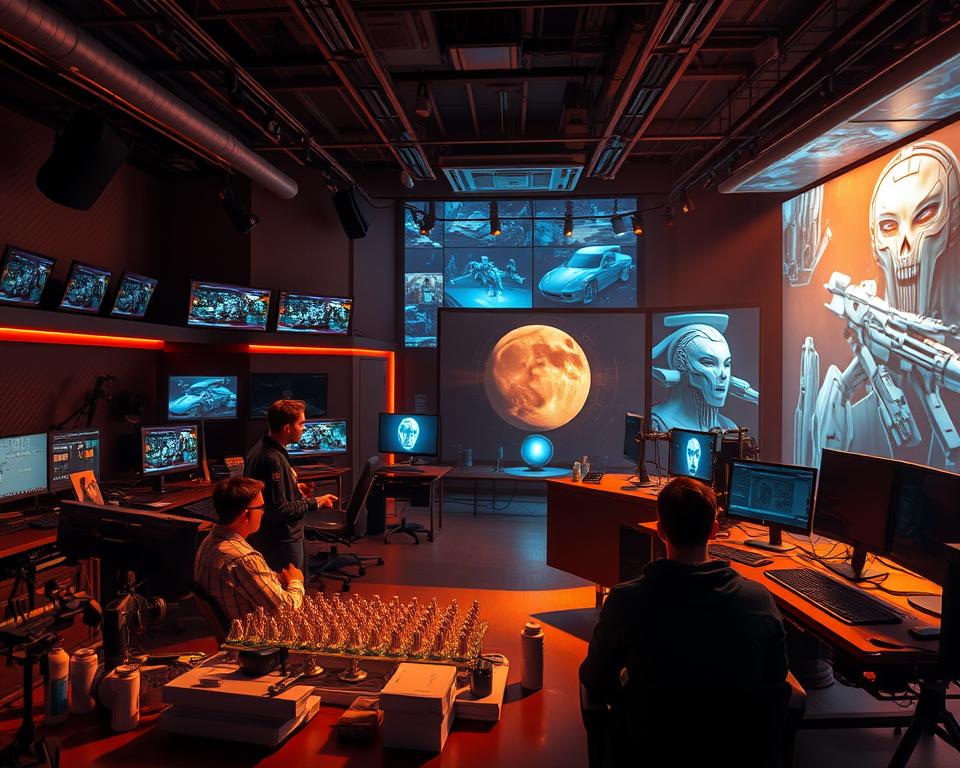
AI-powered middleware is key to this change. These systems connect editing software, rendering engines, and platforms for distribution. They make the process smoother, from idea to final product.
Maximising Efficiency in Production Pipelines
- Automated tagging systems quickly sort media assets, making them easy to find and use again.
- AI quality checks spot errors right away, reducing post-production work by 25%.
- Dynamic scheduling tools
adjust plans when changes happen, avoiding delays.
Utilising AI-Powered Media Production Tools
Tools like Adobe Sensei and Blackmagic’s DaVinci Neural Engine make tasks easier. They handle colour grading, motion tracking, and compositing, saving up to 40% of manual work. This means teams can focus more on the story.
“AI isn’t replacing creators—it’s rewriting how they work,” said analysts at MediaTech Insights. “The real gain is in time saved, not tasks lost.”
By using AI, studios like Frame.io and Resolve see faster results without losing quality. This change is not just about tech—it’s a new way of working together.
Ethical Considerations in AI-Driven Media Production
As ai in media production grows, ethical challenges demand urgent attention. Issues like biased algorithms and privacy risks shape AI tool development and use in content creation.
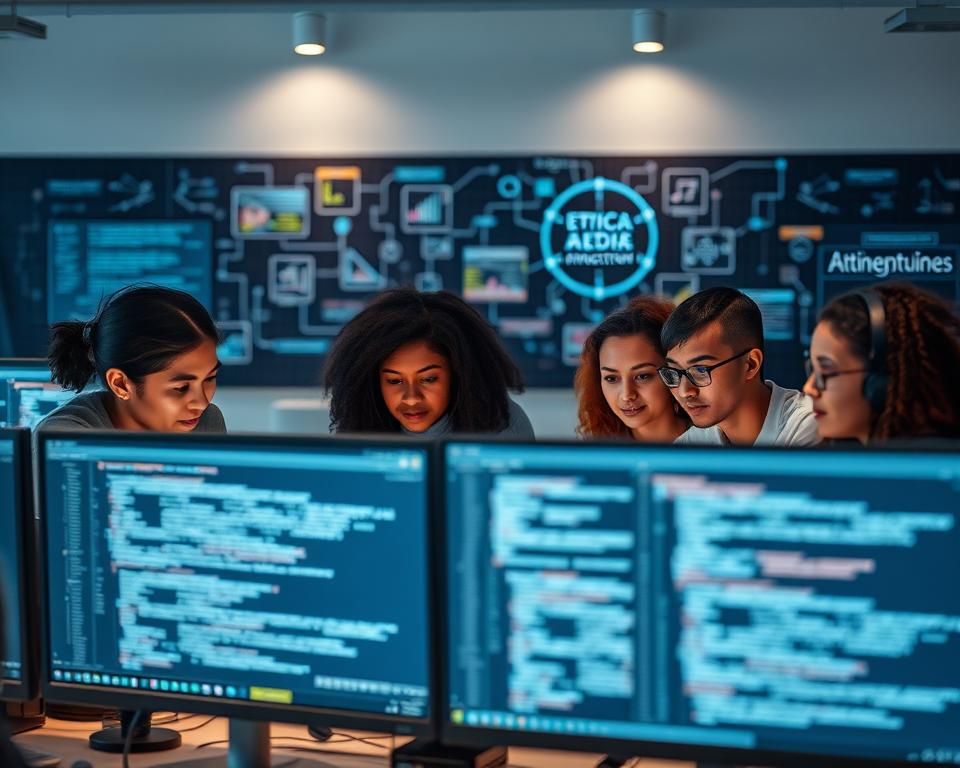
- Bias in algorithms: AI systems trained on skewed datasets may amplify societal prejudices. This affects everything from news curation to advertising.
- Data privacy concerns: Collecting user data to personalise content raises questions about consent and misuse of sensitive information.
- Transparency gaps: Audiences deserve clarity on whether content is AI-generated. This avoids deception through deepfakes or automated misinformation.
“Ethics must be the foundation of every AI tool, not an afterthought.” – UNESCO Media Freedom Report 2023
Media organisations must audit training data to reduce bias. Diverse datasets and regular checks can minimise skewed outcomes. For example, the BBC now mandates bias reviews for AI tools in newsrooms. Privacy safeguards, such as anonymising user data, are also vital to uphold trust.
Transparency is non-negotiable. Labelling AI-generated content prevents confusion. Platforms like The Guardian already flag AI-assisted articles, setting a precedent for the industry. Human oversight remains critical to counteract deepfakes and microtargeted disinformation, which AI systems alone cannot reliably detect.
Collaboration between developers, ethicists, and journalists is key. By embedding ethical frameworks into ai in media production, the sector can balance innovation with responsibility. This ensures technology serves truth, not manipulation.
The Impact of AI on Creative Roles and Job Markets
Artificial intelligence is changing how media workers do their jobs. Automation takes care of tasks like scheduling and basic editing. This lets creatives focus more on storytelling and connecting with the audience.
Big names like the BBC and Sky say 35% of their staff now spend more time on big decisions than on technical tasks.
“AI isn’t replacing jobs—it’s rewriting job descriptions. The future belongs to those who master collaboration with machines.” — Media UK 2023 Report
Teams are now combining human creativity with machine speed to keep up. Let’s look at how roles are changing:
Adaptation in the Age of Automation
- Editors use AI tools to understand what viewers like, making content on the spot.
- Producers work with algorithms to pick the best stories.
- Technical roles now include training AI to make post-production faster.
Evolving Skill Requirements for Future Professionals
New roles need a mix of old and new skills:
| Old Skill Focus | New Skill Focus |
|---|---|
| Manual editing | AI tool management |
| Scriptwriting | Data analysis for audience insights |
| Studio setup | AI system calibration |
Training programs now teach both old and new skills. Universities work with tech companies to offer courses on AI ethics and basics. A 2023 Ofcom study found 68% of UK media firms now look for candidates who know AI, not just software skills.
Future Projections: Automation and the Evolution of Broadcasting
By 2030, machine learning will change broadcasting for the better. Experts say AI use will jump by 40% in media. This is thanks to better algorithms and real-time data.
Emerging Models of AI Integration
There are three main trends:
- Hybrid human-AI workflows mix human creativity with AI ideas
- Predictive tools for audience engagement based on feelings
- Auto-generated metadata for quicker content sharing
Preparing for the Next Wave of Innovation
Media leaders need to focus on:
| Strategy | Action | Example |
|---|---|---|
| Training Programs | Upskill teams in AI collaboration | BBC Academy’s AI literacy courses |
| Pilot Projects | Test AI tools in controlled environments | ITV’s AI-driven newsroom trials |
| Partnerships | Collaborate with tech innovators | Adobe and Google Cloud’s joint tools |
Starting to use machine learning now helps businesses stay ahead. Being ready for the future keeps them competitive in a changing media world.
Conclusion
AI is changing media production in big ways. It automates tasks and makes creative work better. Now, tools like data analytics in video editing can understand what viewers like. This helps teams make stories that really connect with people.
Adobe Premiere Pro and Blackmagic Design’s DaVinci Resolve are already using these technologies. They make editing faster and more efficient.
Even with AI, human touch is key. We need to make sure AI is fair and open. It’s important for professionals to learn about AI tools but not forget their creative side.
The BBC has shown how AI can help, not replace, human creativity in editing. This is a good example for the future.
As AI gets better, it will give feedback in real time. The film, advertising, and news industries need to get ready. By using AI wisely, we can make stories even more powerful and true.